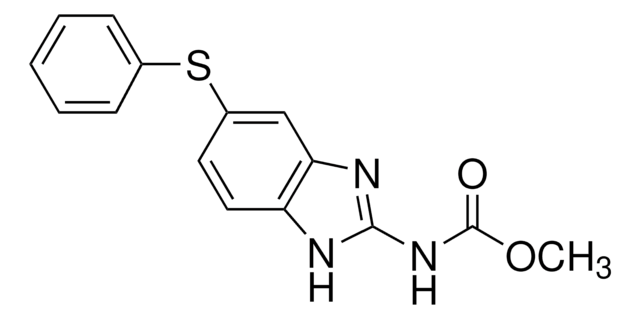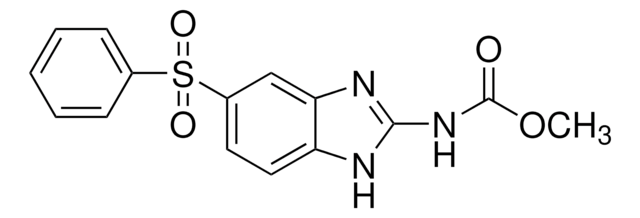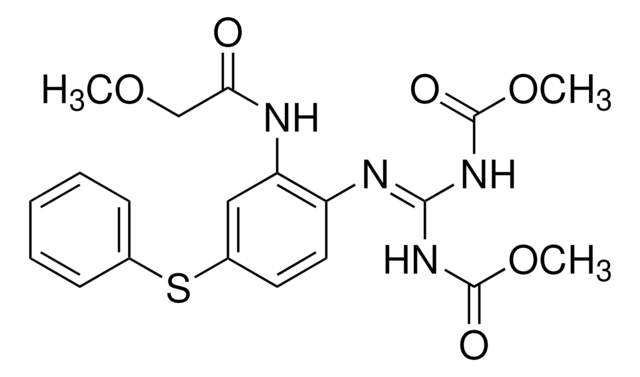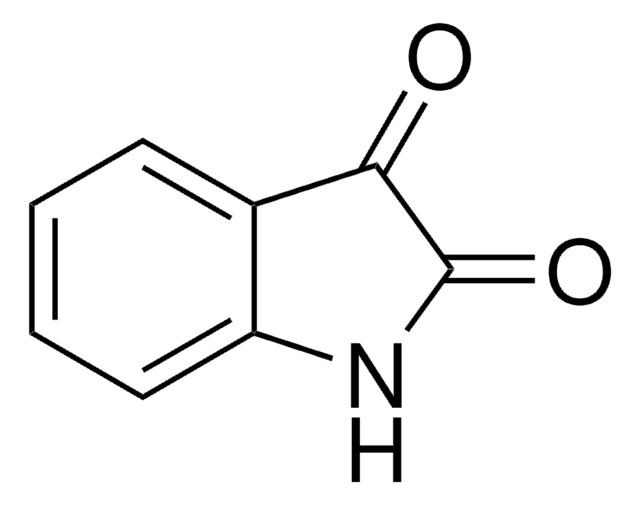F5396
Fenbendazole
≥98%
Synonym(s):
Methyl 5-(phenylthio)-2-benzimidazolecarbamate
Sign Into View Organizational & Contract Pricing
All Photos(3)
About This Item
Empirical Formula (Hill Notation):
C15H13N3O2S
CAS Number:
Molecular Weight:
299.35
Beilstein:
759077
EC Number:
MDL number:
UNSPSC Code:
12352100
PubChem Substance ID:
NACRES:
NA.22
Recommended Products
Quality Level
Assay
≥98%
SMILES string
COC(=O)Nc1nc2cc(Sc3ccccc3)ccc2[nH]1
InChI
1S/C15H13N3O2S/c1-20-15(19)18-14-16-12-8-7-11(9-13(12)17-14)21-10-5-3-2-4-6-10/h2-9H,1H3,(H2,16,17,18,19)
InChI key
HDDSHPAODJUKPD-UHFFFAOYSA-N
Looking for similar products? Visit Product Comparison Guide
General description
Fenbendazole also known as Methyl 5-(phenylthio)-2-benzimidazolecarbamate, is a benzimidazole anthelmintic and antiprotozoal agent.
Application
- Fenbendazole in Veterinary Medicine: Investigated for efficacy against coccidicidal fungi in avian species, demonstrating broad-spectrum antiparasitic potential. Additionally, its environmental impact and pharmacokinetics reveal insights for sustainable agricultural practices and disease vector control. (Lozano et al., 2024), (Hachgenei et al., 2024), (Durden et al., 2023).
- Food safety and allergen detection: Fenbendazole′s implications in food safety are explored through quantitative PCR methods for detecting allergenic species in foods, underscoring the importance of accurate detection techniques in food industry compliance and safety standards (Costa et al., 2023).
- Analysis of antibiotic and anthelmintic residues: The occurrence and exposure evaluation of Fenbendazole residues in cow milk in China is studied, emphasizing the need for rigorous monitoring of food products to ensure public health safety (Chang et al., 2023).
Signal Word
Warning
Hazard Statements
Precautionary Statements
Hazard Classifications
Aquatic Acute 1 - Aquatic Chronic 1 - Repr. 2 - STOT RE 2
Target Organs
Liver,lymph node,Stomach,Nervous system
Storage Class Code
11 - Combustible Solids
WGK
WGK 3
Personal Protective Equipment
dust mask type N95 (US), Eyeshields, Gloves
Choose from one of the most recent versions:
Already Own This Product?
Find documentation for the products that you have recently purchased in the Document Library.
Customers Also Viewed
Penny K Patten et al.
Veterinary clinical pathology, 42(1), 103-108 (2013-01-03)
Mesocestoides cestode infections in dogs are well known for causing severe peritonitis with larvae or larval fragments (metacestodes, tetrathyridia, or calcareous corpuscles) frequently observed cytologically in peritoneal fluid samples. This case report describes the cytologic and clinical features of 2
C Chassaing et al.
Journal of medicinal chemistry, 51(5), 1111-1114 (2008-02-15)
Highly water-soluble prodrugs 1a- g of anthelmintic benzimidazole carbamates 2a- g were synthesized. These prodrugs combine high aqueous solubility and stability with high lability in the presence of alkaline phosphatases. The veterinary utility of 1a was shown by a pharmacodynamic
Nilambra Dogra et al.
The Journal of biological chemistry, 287(36), 30625-30640 (2012-06-30)
In recent years, there has been a great deal of interest in proteasome inhibitors as a novel class of anticancer drugs. We report that fenbendazole (FZ) (methyl N-(6-phenylsulfanyl-1H-benzimidazol-2-yl)carbamate) exhibits a potent growth-inhibitory activity against cancer cell lines but not normal
Niels C Kyvsgaard et al.
Veterinary parasitology, 181(2-4), 248-254 (2011-05-17)
Horses, mules and donkeys are indispensable farming and working animals in many developing countries, and their health status is important to the farmers. Strongyle parasites are ubiquitous in grazing horses world-wide and are known to constitute a threat to equine
Unexpected production loss caused by helminth parasites in weaned beef calves.
N D Sargison et al.
The Veterinary record, 167(19), 752-754 (2011-01-25)
Our team of scientists has experience in all areas of research including Life Science, Material Science, Chemical Synthesis, Chromatography, Analytical and many others.
Contact Technical Service












